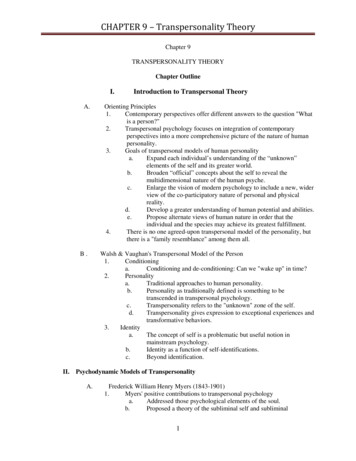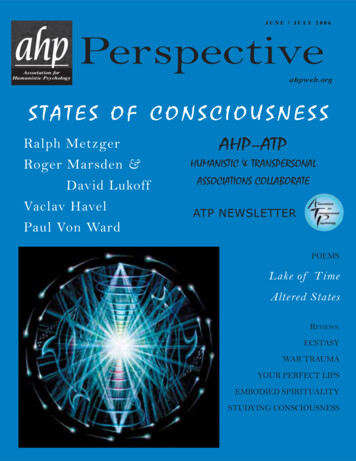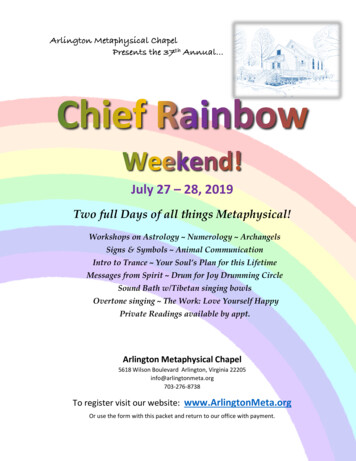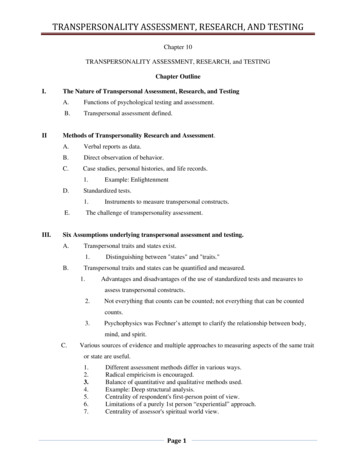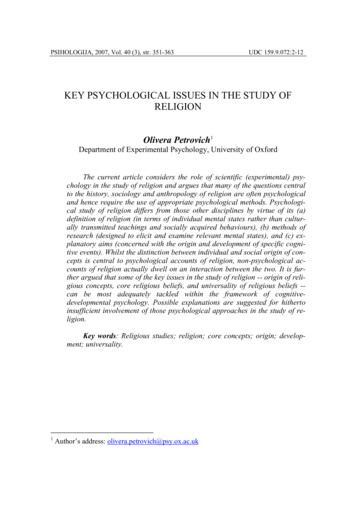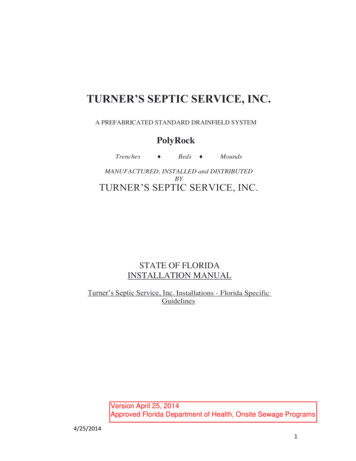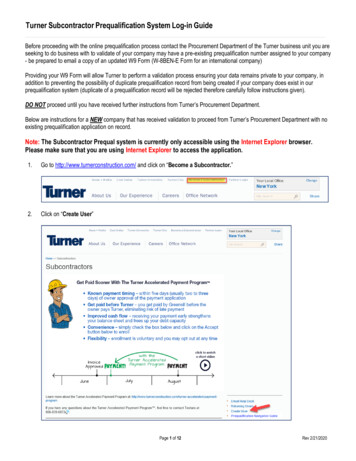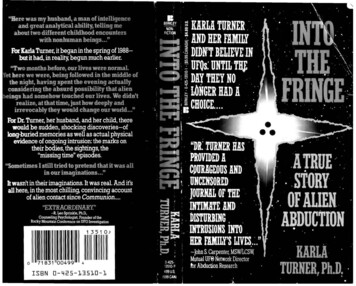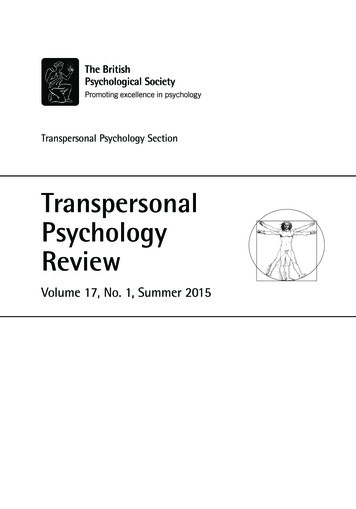
Transcription
Transpersonal Psychology SectionTranspersonalPsychologyReviewVolume 17, No. 1, Summer 2015
Editor: Ho Law, Empowerment Psychology Network, Empsy Ltd. and School of Psychology,University of East London. E-mail: drholaw@gmail.com.Book Review Editor: Grace Warwick. E-mail: gracewarwick@hotmail.co.uk.Consulting Editors:Professor Les LancasterProfessor Chris RoeElliot CohenIngrid SlackStuart WhomsleyJohn RowanLiverpool John Moores UniversityUniversity of NorthamptonLeeds Metropolitan UniversityThe Open UniversityDivision of Clinical PsychologyIndependent ConsultantThe Transpersonal Psychology Review aims to encourage lively and constructive debate, alwaysseeking to recognise the positive qualities of contributions as well as discussing any limitations orareas of dissent. We ask that any criticisms authors make of the work of others should be asconstructive as possible, without losing the force of the critique itself.All contributions should be sent by e-mail attachment to Ho Law at drholaw@gmail.com andshould conform to the ‘Notes for Contributors’, located on the inside back cover.SubscriptionsTranspersonal Psychology Review is distributed free of charge to all Transpersonal PsychologySection members. It is available to non-members 5 per issue from the British PsychologicalSociety, St Andrews House, 48 Princess Road East, Leicester LE1 7DR.AdvertisingAdvertising space is subject to availability, restricted to British Psycholical Society members only,and subject to the approval by the Editor.Cost:Full pageHalf pageSection members 50 30Others 100 60High quality camera-ready artwork and remittance must be sent together by post to:The Editor, Transpersonal Psychology Section, c/o the British Psychological Society,St Andrews House, 48 Princess Road East, Leicester LE1 7DR. Cheques should be made payable toThe British Psychological Society. E-mail: drholaw@gmail.com.DisclaimerViews expressed in Transpersonal Psychology Review are those of individual contributors and notnecessarily of the Editors, the Transpersonal Psychology Section or the British PsychologicalSociety. Publication of conferences, events, courses, organisations and advertisements does notnecessarily imply approval or endorsement by the Transpersonal Psychology Section. Anysubsequent promotional piece or advertisement must not indicate that an advertisement haspreviously appeared in Transpersonal Psychology Review.Situations vacant cannot be accepted. It is the Society’s policy that job vacancies are published inthe Society’s Psychologist Appointments section in The Psychologist. For details, contact theSociety’s Leicester office.CopyrightCopyright for published material rests with the British Psychological Society unless specificallystated otherwise. As the Society is a party to the Copyright Licensing Agency (CLA) agreement,articles published in Review may be copied by libraries and other organisations under the terms oftheir own CLA licences (www.cla.co.uk). Permission must be obtained from the British PsychologicalSociety for any other use beyond fair dealing authorised by copyright legislation. For furtherinformation about copyright and obtaining permissions, contact permissions@bps.org.uk.
EditorialIt is time again to eternityHo LawNCE again, I am writing the editorialthis year at 15:00 on Sunday, 19 July(BST) in Peterborough, UK. Soanother year has gone by. Reading my lasteditorial, I first reported my fond memoryabout our annual conferences. So I do notneed to repeat myself about how much Ienjoyed the 18th Annual TranspersonalPsychology Section Conference last year, andhow special the conference is to me. Instead,I shall let Harold Randall, my colleague fromDemark, tell us about his experience ofattending the Conference. Harold presentedthe conference report from his own perspective, and yet provides a complete coverage ofthe conference presentations, includingthose parallel sessions that he did not mangeto attend!).Those who attended the conference lastyear would know we changed the venue andheld it at The University of Northampton.There were a few colleagues who asked mewhat happened to the regular venue that weused to hold our conference, at Cober HillScarborough. It was clear that over the years,many of us have developed a strong connection to the conference and hence to theplace that it was held. Indeed there was quitea passionate debate at the conference aboutthe change of its venue – some participantseven advocated that to hold the conference,the place would need ‘a soul’. The discussioncontinues well beyond the conference withinthe Section Committee. On balance weobserved that when comparing the twovenues, there are pros and cons – in terms ofits access, provisions and so on. In termsof number of participants, there was nodecrease in number – it seems that adifferent location attracted some newOparticipants, though lost some past attendants for various reasons Anyway, for those who are still yearningto return to Cober Hill Scarborough, youmay be pleased to know that once again,our Annual Conference will be heldthere this year on 18–20 September.See www.kc-jones.co.uk/transpersonal2015As the last year’s conference theme wason ‘Contextualising Mindfulness: Betweenthe sacred and the secular’, its report, workshop and papers have been presented, thereis no Special Section on Mindfulness in thisIssue. For those who are interested to jointhe Mindfulness Reading Group (MRG),which was set up in September 2013 at theUniversity of East London (UEL), you maylike to know that in the future, the monthlyMindfulness Reading Group (MRG) meetings will be held at The British PsychologicalSociety (BPS) London office between12:00–13:30 on ?. The meeting is open toboth BPS members and non-members.Although the initiative was partly triggered by my departure from UEL in Junethis year, it was mostly due to my ongoingprofessional commitment to promotepsychology as I see the move as a way toimplement some of the BPS strategic goals1–5 (See www.bps.org.uk/strategicplan).The proposal to launch the meetings asinterdisciplinary CPD events received unanimous support from both the Psychotherapyand Transpersonal Psychology SectionsCommittees. It forms a unique CPD eventand represents an interdisciplinary andcross-sectional collaboration. The exactdates will be announced through the Mindfulness Interest Group email-list. If you wishto join the Group email-list and/or simplyTranspersonal Psychology Review, Volume 17, No. 1, Summer 20151
Editorialkeep in touch, please contact me. Dr JamesWalsh and I used to take on the role of facilitator for the meetings. I shall continue withthis role and coordinate at the BPS LondonOffice. However, more volunteers would bewelcome so that we can take turns to facilitate. If you want to be a volunteer, please letme know (see contact details at the end ofthis article).Back to this Issue, as said, we start withthe Conference report by Harold Randall;followed by Elliot Cohen’s paper which notonly summarises his workshop on the ‘Holdand Release’ practice as a new way into meditation and mindfulness, but also provides atranspersonally-informed discourse on thepractice from traditional Daoist, Kabbalisticand Vedantic perspectives. In the search ofhis Afrocentric spirituality, Dwight Turnershares with us in his paper with hiscolleagues – the sacred dream and journeythat took him back to the top of VictoriaFalls in the Zambezi River – which opens upa broader discussion and initiates a call foran intercultural approach to the Transpersonal to include the ‘spiritual other’.Last Issue reported on some key aspectsof Ken Wilber’s work and the possible misunderstanding and misinterpretation byHartelius and Ferrer (2003) by John2Abramson. A debate is ensured, as it openedup a series of discussions. This Issue reportson the on-going unfolding conversationsbetween Hartelius and Abramson. Mike Rushin his paper on The contribution of WesternEsotericism to Transpersonal Psychology,discusses its implications and the potentialfor a re-synthesis of the two traditions.In this Issue, we have introduced a specialSection that includes papers from individuals and independent scholars who offertheir specific insights on topics that theyhave personal experiences and/or particularexpertises in. It starts with Emma Shacklewho shares with us her unique and personalexperience in and observations on being atwin. In her paper – Twins and the Transpersonal – she argues that twins are not singletons and their voice should be heard.Stephen Sayers offers an interestingaccount of the past and the future beingassimilated to the present in his paper onTime and Eternity. And finally, we end thisIssue with a beautiful poem by John Rowanon The Ordinary Mystic.Ho LawEditordrholaw@gmail.comTranspersonal Psychology Review, Volume 17, No. 1, Summer 2015
Conference ReportThe 18th Annual Transpersonal PsychologySection Conference 2014 –A personal experienceH.W. RandallROM MY EXPERIENCE, arriving at aTranspersonal Psychology Conference islike entering a mountain tunnel.Suddenly the light changes. Just as suddenlybright spots begin to appear, above and tothe sides. Each of them one after anotherspills in through one’s window, then fadesinto the background, as another delivers itsbonne bouche. One can change tracks, butnot direction. Forward thrust may be felt tovary at times, but one is drawn steadily alongby the gentle nurture of a deeper current. Weare engrossed. There is seriousness, there islaughter. There are both cognitive and meditative heights, and there are floatingmoments of pleasure. Eventually the tunnel’send becomes perceptible. One continuesunperturbed. By the end of the tunnel, newlygathered morsels lay loosely enfolded underthe pre-frontal bonnet that had opened andclosed, opened and closed, like an excitedchattering chipmunk, as one rolled along.This body of expansive information, thisportmanteau of electrolytes, one carries forthto encounter normal traffic again.That is one way to look at it. Butmetaphor itself can be like air pouchesunder one’s feet. Yet I am less inclined tocompare the booty from a TP Conference tomorsels that have been gathered into abaggage compartment like a picnicluncheon prepared for the alimentary canal.The experience is definitively more of aspiritual character.It happens every time; may be to theorganisers’ credit; I am not sure. But oneFthing is certain, they are the architects of thepassageway. The presenter-vehicles passingalong that passageway are those for whom itwas designed, and those who fulfil its yearlyarchitectural genius, like the water in awater trough.The18thAnnualTranspersonalPsychology Section Conference, 2014,converged with the expressed purpose ofdistinguishing where mindfulness practicemay be understood to appear along the spectrum of the sacred and secular. To submit asingle, more specific statement of itspurpose: to determine how the experienceof mindfulness, which has its origin in anEastern, sacred context, has come to differ, ifat all, in terms of method and accomplishment by its application in secularly orientedforms of therapy and other health practiceshere in the West, particularly the UK.As one of the attendees of the conference, I can say that the conference has morethan lived up to the tunnel analogy above. Asto whether the basic quest was achieved, nothaving regarded the results of the Conference Feedback Forms or heard from theviews of others, I can relay only my ownjudgement, which has passed from ‘convoluted’ to ‘maybe’ to ‘apparently’. Despite acomposition of 50 trillion cells and a superficial nature of dualistic parts – two feet, twoeyes, two ears, etc. – presenting oneself to allof the paper/workshop sessions was notmanageable. What is recallable after a weekor two of normal traffic, which includedtransition through an elevation of 30,000Transpersonal Psychology Review, Volume 17, No. 1, Summer 20153
H.W. Randallfeet, is another confounding matter. Whilethe sequence of events that surfaced inpersonal, mental space has naturallyspiralled into cosmic space, some highlightsof the presentations, with an attempt toaccount for them with equanimity, aided bythe Book of Abstracts, may be recapitulatedas follows.It began with warm exchanges of experience, warm coffee, and warm, official,opening announcements [by the SectionChair]. Following this, in the hush ofanother room [for a paper presentation on‘Mindfulness is not meditation, just selfawareness’ by John Rowan], in the companyof many attentive ears (silently propelledvehicles). the term ‘mindfulness meditation’was right off charged to be a misnomer;instead of mindfulness being taught by thecounselling services, it was (and still is)rather ‘self-awareness’ through meditationthat was being cultivated without any realattempt to convey whatever may lay in theconcept of ‘beyond the ego’. ‘Mindfulnesshas nothing to do with meditation nortranspersonal levels (of experience)’ – thesubtle, and causal levels. ‘What effect didthat have on you?’ is yes/no thinking and haslittle to do with third tier thinking.In the same venue, the next paper[‘Mindfulness--Awareness through Conceptual Analysis: An Approach by the TibetanBuddhist Gelug School’ by Unjyn Park],which drew on an acquaintance with theTibetan Buddhist Gelug School, posited thatmindfulness used as meditation in counselling tends to focus on stress reduction,and it is thereby extracted from its original,soteriological context; it may developconcentration, but it would tend to focus onthe personal domain and not necessarilydevelop a better understanding of thebroader reality in which we are immersed;personal stress reduction is not the samegoal as development of spiritual awareness.Two other papers were presented in aneighbouring room, in parallel to the abovementioned two. One presenter [Anita SianHickish on ‘A Phenomenological Investiga4tion of Trance Mediumship: Toward anunderstanding of meaning making’] – along-time practitioner of Aikido – spoke ofembodying the immanent in transpersonalwork; of techniques that help unification ofour being by minding the body andembodying the mind; that embodiment isboth personal and transpersonal. The otherpaper [‘Care & compassion – Two sides ofone coin perhaps?’ by Alex Gardner]focused on behaviours that are central forhuman inter-identification and the survivalof humanity; it posited care and compassionas two sides of the same underlying attitudinal or belief process; that while they maybe intrinsic, emotional fatigue can resultfrom activities such as fund raising, etc.; andthat the two processes, rooted in Agape, canbe regarded as ‘spirituality in action’.I found some coffee and cup-in-handreturned to the same venue to peruse andappreciate the many, intricately fine, information-rich poster presentations. Forpurposes of conciseness here, I shall takeadvantage of the axiom ‘a picture is worth athousand words’ and leave it at that.In the Keynote that evening the questionof whether mindfulness training truly can besecular was (again) posed [by Tamara Russellon ‘Can mindfulness training really besecular?’]. Some of the ways in which mindfulness has been ‘adapted’ to the needs ofcertain clinical groups as well as healthcarestaff has had positive results in groups witheating disorders and bipolar illness.; the‘Body-in-Mind Training Framework’, theproduct of the presenter – a practitioner ofTai-Chi – was described as a ‘body-basedmindfulness’Then came dinner, conversation, andwine. The wind currents of the tunnelchurned out a harmonious tune as the lightstended toward a merged wholeness.Saturday, 07:00, the Keynote presenter ofthe previous evening led a few attendees inTai-chi exercises. Shoes wet, red-faced,refreshed, but deeply relaxed, we headed énmasse for breakfast. At 09:15 I and manyothers embarked on a presentation thatTranspersonal Psychology Review, Volume 17, No. 1, Summer 2015
Conference Reportposited (again) significant differencesbetween sacred and secular uses of mindfulness [‘Intention and presence in the practiceof IRECA: mindfulness as a means, not anend?’ by Chris Pike] Mindfulness used incounselling seeks positive effects at the physiological level. The role of intention is,however, underplayed; using a middleeastern healing modality, activation of theleft-frontal lobe was found to result from‘genuine treatment’, while nearby randomevent generators issued non-random results,compared to placebo and non-treatmentcontrols.Next was a paper on studies of spiritualistmediums [‘What can we learn from anexploration of the phenomenology of Spiritualist Mental Mediumship?’ by Chris Roe &Liz Roxburgh], who claimed experiencesbeyond the personal domain, such as contactwith the spirits of the deceased; comparisonswere to be made with Brazilian research intoSpiritism; this area faces the challenge ofaccounting for such experiences in conventional terms; while questions of well-beingcontra pathology and transcendence ofbeing contra self are held in balance, thestudies are believed to inform our understanding of consciousness and Higher Self.Related to the same area of inquiry, oneof the two sessions running parallel to theabove two explored why psychedelics andpossession are traditionally, rarely combinedwhen Shamans communicate with spirits ofthe dead [‘Psychedelic Possession: Incorporating incorporation into plant shamanism’by David Luke]; the other paper reported ona study using Q-methodology to explorepractitioner understanding and use ofLoving Kindness Meditation [‘Understanding Loving Kindness Meditation; A Qstudy with practitioners’ by Kim Sheffield].After the infusion of two cups of coffee,spirituality (contra spiritualism) was directlytaken up. two papers proposed ways in whichspirituality may be understood and developed. The first [‘Spirituality in PersonCentred Perspective’ by Tony Lawrence]considered the relationship between spiritu-ality and person-centred therapy; it cited thenineteen propositions of Carl Rogers,purported to describe individual development from pre-self to post-self stages; thesewere in turn discussed in relation to othertranspersonal theories of spiritual development. Subsequent to this was a report [‘Spirituality as an Integration of Psychology andReligion: Problems and Possibilities’ byFraser Watts] arguing that while mindfulnesscan be practiced for both religious,moral/transcendent as well as secularpsychological interests, it thirdly can be cultivated as simply ‘spiritual’, embodying bothimpersonal-religious and practical-secularpurposes.Both of these papers were paralleled by aworkshop [‘The Hold and Release Practice: ATranspersonal Exploration’ by Elliot Cohen]that taught a simple ‘Hold and ReleasePractice’, developed by the presenter, that canbe used as preliminary practice for teachingsitting meditation in general; the techniquehas its roots in Daoist culture, including YinYang cosmology, Daoyin, and Qigong.The purposeful use of mindfulness forsecular purposes was argued in a positivevein in an after-lunch Keynote entitled:‘Mindfulness: Sacred or Secular – does itreally matter?’ [by Michael Chaskalson]. Thespeaker, an advocate of Mindfulness basedstress reduction (MBSR) and the use ofmindfulness in workplace settings, posited:‘At the moment of experiencing, there is noego-self’; and (if I understand my notescorrectly) ‘Mindfulness is about being moreaware of yourself, others, and the worldabout you’.Late afternoon moved one’s attention toa consideration of the reticence that someteachers have shown in teaching religiouseducation (RE in the UK). Even so, RE hasbeen asserted to contribute to communityrelations; mindfulness practice was regardedfor its possible contribution to cross-culturalexchange; the concept of mindfulness wasinvestigated among RE teacher trainees, whodiscussed how it could be used on a personalbasis and within the primary classroom.Transpersonal Psychology Review, Volume 17, No. 1, Summer 20155
H.W. RandallA parallel workshop cited evidence forhow the impact of creative activities can bepersonally empowering, and how theytogether with mindfulness interventionshave fostered mental health; in this interestmulti-modal exercises were introduced andexplored [by Jessica Bockler on ‘Creativity &Mindfulness for Health’].The evening Keynote, [‘Mindfulness andthe transpersonal traditions: Beyond reductionism’ by Geoffrey Samuel’] the Directorof the Body, Health and Religion ResearchGroup, led us in a consideration of thecomplex, sacred origins (pre-Vipassana;Theravada vs. Vajrayana) of MBSR; meditation is the core of Buddhism, and its traditions are ‘beyond reductionism’.The annual panel discussion followingthe Keynote was vibrant. Then came dinnerwith wine, which poured over into merriment and volunteered entertainment, asper tradition. There were guttural echoesfrom Tibet accompanied by guitar, melodious Celtic notes on the violin, and fullbarrelled baritone plus tenor lullabies fromScotland. In such a gathering, no clamouring sense of aesthetic judgement coulddampen the urge to cast outward upon theenvironment one’s inspiration.Sunday, for some, began with clinicalparapsychology in the UK [‘Clinical parapsychology in the UK: Counselling for Anomalous experiences’ by Rachel Evenden & LizRoxburgh]; about how clients with anomalous experiences (AEs) report to secularcounselling services; how they may be bettersupported by specialist training of the therapists, especially in light of their havingexpressed a need for such preparation. Thiswas followed by a Paper [‘Monkeys’ paws,poppets, sheep and goats; or, the necessarycomponents of successful spells’ by Charmaine Sonnex] reporting on interviews ofprofessed Pagans, recruited online, andtheir experiences, including spell-casting asa positive art of healing; about how effectiveness of such healing requires ethical ‘intentspecificity’, in order to disallow unintendedresults; how it has been observed that people6cannot be made to do what they normallywould not; and, stressing the importance ofnot being manipulative, how one must askfor a subject’s permission to cast a healingspell - all of which implements ‘focus’.A parallel session [‘The CompassionateUniversity: Policy, Rhetoric, or Reality?’ byScott Buckler] started with an introductionof Salzberg’s assertion that the culminationof mindfulness is the development of lovingkindness and compassion; while focusedattention and open monitoring tend to beprevalent as mindful practices, the principleof compassion has acquired focus in sectorsincluding business, environment, healthcare, science, and research; the tensions andprospective solutions regarding the development of a ‘compassionate university’ wereexplored. In the other parallel Papersession, [‘Searching for Afro-Spirituality:Creating a space for African spiritual traditions and meaning within the Transpersonal’by Dwight Turner, Jane Calaghan, & AlasdairGordon-Finlayson] it was posited that a trueperennialist theory of spirituality wouldsubsume the forms of spirituality found inalternative world cultures; the complicatedrelationship between God, the spirits, ancestors, and humanity in African spiritualitywere explored; from the perspective ofAfrica, without the input from cultures otherthan the major western and eastern religions, the concept of the transpersonalcould seem to have a ‘neo-colonial cloak’.Finally, the Keynote on Sunday evening[‘From caves to laboratories: Buddhist meditation practices in contemporary society’ byPeter Malinowski] focussed on the shift ofthe study of meditation ‘from caves to laboratories’. Starting with the ‘cave’, thepresenter relayed the message of one of histeachers, Lama Nydahl: mind cannot befound, it is not a thing; it is not a matter ofimproving health; ‘forget it!’ Then thepresenter moved over to the laboratory.Fromanothersource(apparentlyacquainted with the cave), structuring interms of identifying neural mechanisms ofattentional control, as in meditation, is theTranspersonal Psychology Review, Volume 17, No. 1, Summer 2015
Conference Reportresult of ignorance. Big claims for MBCT?Not so, such claims are not supported by thelab data. Attempts have been made tomeasure the effects of mindfulness using amultimodal approach, which in particularincluded neurophysiological tools, such asEEG. The presenter stated he does notdistinguish between focused attention andopen monitoring, as they ‘both are alwaysthere’. He reiterated the claims of otherinvestigators that secular interests look to thetechnique of mindfulness (meditation) toaccomplish specifiable ends; in contrast tothis, the learning and experience of mindfulness was originally believed to lead toBuddhahood; and, in the terms of anothersource, Buddhism is like a clear crystal – putit on a blue surface, and it will become blue.The tally of the reports as representedhere seems to comprise three groups: (1)those who emphasise the difference betweenthe sacred origins and the secular uses ofmindfulness practice as distinct and essentially non-unifiable; (2) those who suggestthat both lay on the same continuum, andfor that matter practical use may move onecloser to the ends realised by thoseapproaching it as sacred; that by applyingwhatever constituent techniques they use todefine or identify mindfulness practice in asecular context, results have been shown tobe positive; and (3) those who do not makeclear their relationship to mindfulness asmeditation or practice.Of group 1, there were apparently fivePapers; group 2, eleven papers; and group 3,five papers.The conference was to address three(four) interrelated questions: (a) ‘To whatextent is mindfulness practice promulgatedin therapeutic and social contexts true to itsroots in the spiritual traditions?’; ‘Have thebounds of the term ‘spiritual’ become soelastic as to be of little value?’; (b) ‘Whatimpact is the widespread incorporation ofwhat is at core a spiritual practice having oncontemporary society?’; and (c) ‘Is the popularisation of meditation practice leading to adistortion of the root traditions from whichit has been extracted?’Group 1 suggested that in answer to questions ‘a’ and ‘c’, secular practice is not trueto mindfulness roots; that ‘mindfulnesspractice’ has tended to change meaning byits importation to the west from its lands oforigin. Group 2 would not seem to deny thatposition, at least directly, but they wouldaddress question ‘b’ by emphasising that theway they understand and apply mindfulnesspractice has positive results.Commentary – mostly questions‘The result of ignorance?’ But isn’t that whyone studies the mind? And why is it pointless to do so in the see-it-as-an-object waythat some in the west do? Studying the‘mind’ seems like a larger order of interestthan studying the direct and indirect effectsof meditation on personality and brain – thebehavioural and neurophysiological.The secular interest in ‘mindfulnesspractice’ would seem to be initially that ofenabling one to face practical aspects ofone’s life, for which an increase in the development of self-awareness seems primary. Thesecular interest offers a means to ends thatare specifiable.In contrast, the sacred interest in mindfulness practice is or remains that of transcending the practical aspects of life; ofexploring how our lives may be understoodand experienced in terms of that which maybe universal, or in any case how one canrelate to whatever may lay beyond conceptual apprehension or conscious apperception, with which we associate spiritual originsand ties.The question remains: will the positiveresults from the secular applications naturally and eventually become the same asthose who have an acknowledged interestin developing an understanding of theuniversal context of humanity?The overall result as represented hereappears to contribute to situating mindfulness between the sacred and the secular.However, if it is correctly to be regarded on ascale, then should there not be some mark-Transpersonal Psychology Review, Volume 17, No. 1, Summer 20157
H.W. Randallings on the scale that indicate steppingstones, if not thresholds?My understanding and practice of mindfulness is that of an experience generallyentered after entering a meditationalprocess by other means or techniques. It isan advanced form of meditation, and as suchits practice would follow acquaintance withother forms of meditation practice, given theright interest and openness.Should the differences of forms of meditation, all of which can have a constructiveeffect, not be acknowledged within thecontexts of so-called secular applications?Developing concentration by focussingon either an external or internal object ofthe senses, perfecting an art of a physicalnature, developing an ability to remain openand consciously ride on the wave of anemotion, etc.; as all who read the Transpersonal Review would know, there are differentways to approach an essentially internalexperience that may begin with the personaland lead toward the beyond-personal. If notby the term ‘mindfulness meditation’, thenhow is the experience of advanced meditators in the East to be represented?8Shouldn’t ‘mindfulness meditation’ bedistinguished from ‘mindfulness practice’?If one enters meditation with an undercurrent of fear or apprehension, would notthe meditative experience tend to bedifferent than if one entered the meditativeprocess with an undercurrent of love and/orpositive regard?How can one put down in writing what isin the ‘mind’? – a generalised expressionfrom B. Dylan.When can language ever capture and faithfully represent such internal experiences tothe point of conveying it to a non-practitioner?Lastly, I offer my apologies to those whomI may have misrepresented. A lot of information was dished out at the conference, and itseems that only bits of it still cling to thestructure under the pre-frontal bonnet. Allcorrections, complaints, and comments, evenon the punctuation, will be welcomed.
and Transpersonal Psychology Sections Committees. It forms a unique CPD event and represents an interdisciplinary and cross-sectional collaboration. The exact dates will be announced through the Mind - fulness Interest Group email-list. If you wish to join the Group email-list and/or simply Transpersonal Psychology Review, Volume 17, No. 1 .
